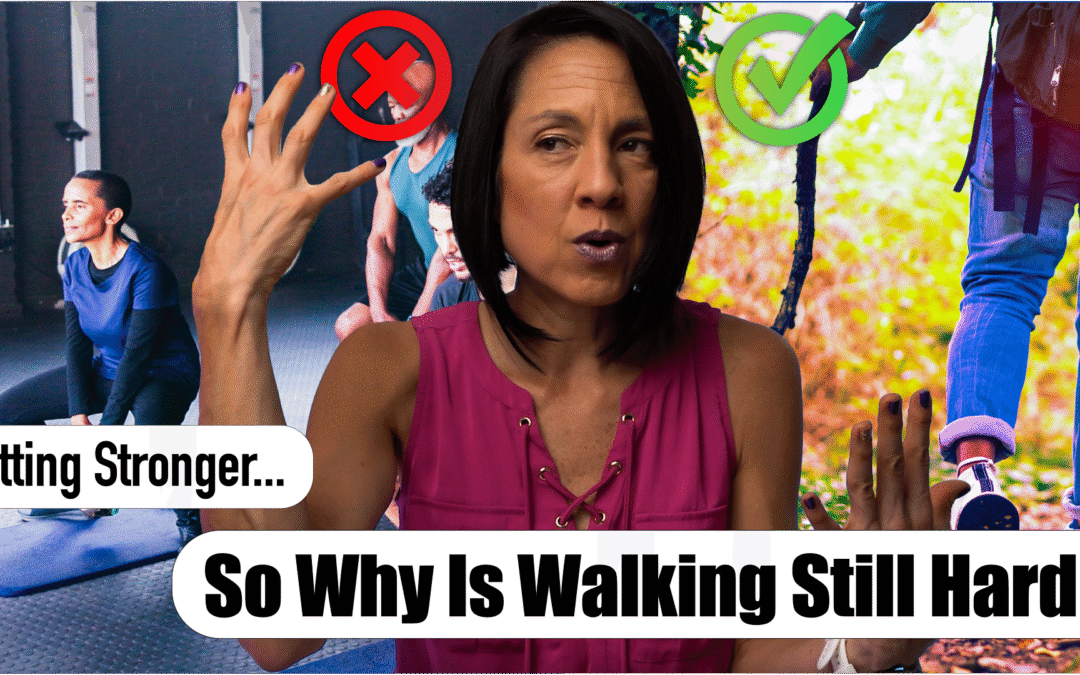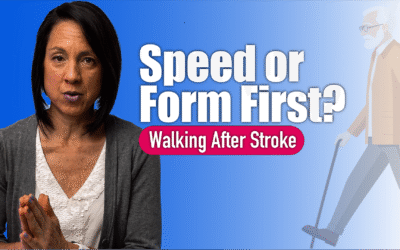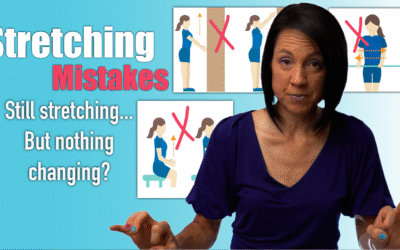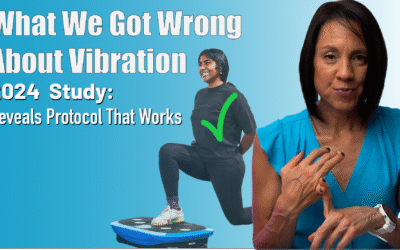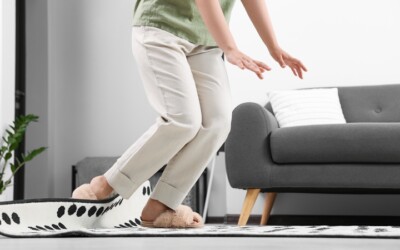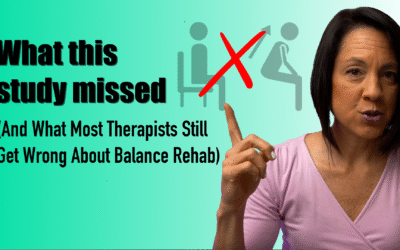Stroke Recovery Tips: When Exercises Don’t Seem to Work
Is it possible to be making progress after a stroke or neurologic injury and still feel like your movement is getting stiffer, heavier or just plain harder?
Absolutely. And let me tell you, it is one of the most frustrating things I see in recovery.
So why does this happen? Why can you be “getting stronger” but feel like your movement quality is getting worse? And more importantly, how do you measure progress in a way that actually helps you get better?
Strength vs. Motor Control – They’re Not the Same Thing
A common frustration I hear:
“I feel stronger, but my walking feels heavier.”
“Some days my leg won’t move at all.”
“I fatigue so quickly, even though I know I’m improving.”
This all comes down to understanding the difference between strength and motor control.
When you’ve had a stroke, it’s not that your muscles are simply “weak.” The problem is that the operating system, your brain’s code that controls movement has been damaged.
Think of your brain like a computer. Your muscles are the keyboard and they still work. But the hard drive that runs the programs? That’s where the damage is. When a stroke wipes out part of the “code,” your muscles can’t execute normal movement patterns anymore.
So what do most people do? They fall back on what they know: strengthen, strengthen, strengthen. But strengthening alone often reinforces abnormal movement patterns (like spasticity or those stiff, locked movements). And the more you push into those, the more your brain rewires around them. We call that negative neuroplasticity.
So What Can You Do?
Focus on Motor Control
Here are some strategies I use with my patients to turn all that effort into quality movement that feels better and translates into daily life.
1. Sensory Input Matters
Things like tapping, rubbing, vibration, or even just moving the arm or leg passively, these all remind your brain: “Hey, there’s a limb here, pay attention!”
It’s like reintroducing your brain to your body again.
2. Prioritize Quality Over Quantity
Don’t just celebrate movement for movement’s sake. Watch how it’s moving.
If your arm rotates in oddly when you lift it or your hand closes with your thumb tucked, stop and adjust. Reinforcing abnormal patterns makes them harder to break later.
3. Break Skills Down
Walking is a perfect example. Instead of endless squats and lunges, focus on the exact part of walking that’s giving you trouble.
- Practice weight-bearing without locking your knee.
- Practice swinging the leg without relying on abnormal patterns.
- Practice lifting your ankle with your knee straight.
This helps rebuild control, not just strength.
But Also… Don’t Forget to Just Walk
Sometimes, the best thing you can do is the obvious: walk more.
I see so many people get caught up in finding the “perfect exercise” when what they really need is more time on their feet.
Just like toddlers, they don’t get drills, they just keep practicing until it clicks.
The Big Takeaway
Feeling like your movement is “worse” while you’re working hard can actually be a sign that your brain is still figuring things out. The key is shifting your focus from strength alone to motor control, and making sure the movements you’re practicing are high-quality and moving you closer to normal function.
And if you want more structure and guidance on how to do this in your own recovery, that’s exactly what we’ve built inside our Rehab HQ membership program. You get access to tools, exercises, and step-by-step guidance so you can take full ownership of your rehab, on your own terms.
You can learn more or sign up here.
I hope this helps connect some dots for you.
Remember: Progress isn’t always a straight line, and sometimes “worse” movement is just part of the path to better.
Articles you may be interested in
Is Your Neuro Rehab Helping Your Recovery, or Making Things Worse?
The Real Impact of Neuro Rehab on Recovery https://youtu.be/YDgQc4p_atE Recovering after a stroke often involves long hours of rehabilitation. Neuro rehab programs are designed to retrain the brain and body, helping survivors regain independence. Understanding...
How Short Bursts of Exercise Boost Brain Healing
HIIT for Stroke Recovery Boost brain rewiring, improve movement, and speed recovery with short bursts of exercise. https://youtu.be/4SgXN2uRX8g If you’ve been on your stroke recovery journey for a while, you’ve probably heard the word neuroplasticity. Neuroplasticity...
Stretching Spastic Muscles: 8 Mistakes to Avoid
8 Common Stretching Mistakes in Stroke Recovery Why Your Stretching Might Be Making Spasticity Worse https://youtu.be/bBsM34HROYY If you’re dealing with spasticity after a neurologic injury, stretching might not be as straightforward as it seems. In fact, doing it the...
New Study: Vibration Plates Boost Balance After Stroke
It Just Vibrates… So Why Are Stroke Survivors Getting Better? The Truth Behind the Research https://youtu.be/GZgGsMjEgJQ When vibration plates first became popular, they reminded many of us of those old 1980s machines that promised to "shake" the fat away. Naturally,...
Walking “Tips” that Sabotage Post-Stroke Progress
Recovering from Stroke? Don’t Let These 7 Walking Mistakes Set You Back Better Walking Starts by Avoiding These Mistakes https://youtu.be/_nkjHLdOeLc Recovering your walking ability after a stroke is an incredible accomplishment. You’ve put in the work. Strengthening...
The Hidden Reason Your Walking Feels Off After Stroke Rehab
The Missing Link in Stroke Rehab: Why Strength Isn’t Enough How Plyometric Exercises Can Improve Your Post-Stroke Walking https://youtu.be/0xzcgTifCiM Recovering from a stroke is a journey that takes patience, effort, and persistence. Maybe you’ve been faithfully...
Struggling with Shoulder Pain After a Stroke? Here’s What Works
Why Does My Shoulder Hurt After a Stroke?Understanding the 6 Most Common Causes and What You Can Actually Do About Them Let’s be real — if you’re recovering from a stroke and your shoulder still hurts, it can feel really defeating. Especially if you’ve been doing “all...
Still Feeling Weak After Stroke? This Might Be Why
Doing the exercises… but still not getting stronger?You’re walking. You’re moving. Maybe even getting stronger.But everything still feels hard. Like walking across a room takes full concentration. Or standing up while talking feels like solving rocket science....
Stroke Recovery: Spasticity vs. Adaptive Shortening vs. Contracture
Stroke Recovery: Spasticity vs. Adaptive Shortening vs. Contracture Muscle tightness after stroke is common and can be the greatest barrier to restoring normal arm and leg movement. But not all tightness is the same. To treat it effectively, you need to understand...
Why Eccentric Control Might Be the Missing Link in Your Stroke Recovery
Why Eccentric Control Might Be the Missing Link in Your Stroke Recovery After a stroke, movement rarely returns the way we’d like. Instead of smooth, controlled motion, you get stiffness... or those annoying synergy patterns—where every muscle seems to fire at once....

